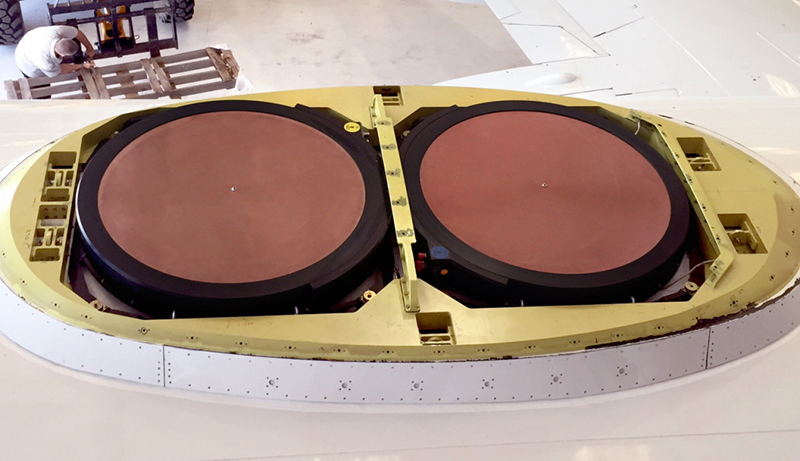GoGo, the largest provider of Internet above 30,000 feet, has announced they are now testing their next generation of in-flight Internet.
Of special interest in the new 2Ku system is the antennas strapped to the top of a GoGo-equipped plane’s fuselage. These antennas form a mechanically-phased-array that are more efficient than previous antennas and can provide more bandwidth for frequent fliers demanding better and faster Internet.

Currently, GoGo in-flight wireless uses terrestrial radio to bring the Internet up to 35,000 feet. Anyone who has flown recently will tell you this is okay, but you won’t be binging on Nexflix for your next cross country flight. The new system promises speeds up to 70Mbps, more than enough for a cabin full of passengers to be pacified by electronic toys. The 2Ku band does this with a satellite connection – much faster, but it does have a few drawbacks.
Because the 2Ku system provides Internet over a satellite connection, ping times will significantly increase. The satellites GoGo is using orbit at 22,000 miles above Earth, or about 0.1 light seconds away from the plane. Double that, and your ping times will increase by at least 200ms compared to a terrestrial radio connection.
While this is just fine for email and streaming, it does highlight the weaknesses and strengths of mobile Internet.
















Nice hack!
How’s this a hack?
It isn’t.
My thoughts, guys! I should put it into ‘sarcasm’ html tags, though.
It isn’t a “hack” per se, but it probably started with an idea, and then became a hack, and is now moving beyond the “hack” stage. It is (warning, trite phrase ahead!) leading edge electronics and hackers like to learn/know about such things as it gives them new stuff to hack on.
While this is a decent bandwidth upgrade, it’s largely irrelevant since the majority of high-bandwidth traffic is filtered out anyway to improve quality of service for everything it’s actually reasonable to use internet on a plane for. Youtube/Netflix/Hulu/whatever can wait until you’re off the plane, and I believe the majority of games are also blocked. Simply put, there’s no current way to have enough bandwidth over a (relatively) stable wireless, mobile connection outside of cellular range to allow for video streaming (at what most consider acceptable quality) for more than a couple of people at a time, and any solution that allows for that is unlikely to appear on planes for quite some time.
And that’s okay with me… If I REALLy want to watch a certain video on a plane, I can bring a portable DVD player.
Most who intend to watch something will, though that doesn’t make it any less annoying when someone’s small child starts screaming because their video won’t load or their game won’t work and the parent doesn’t shut them up.
It’s 2015. Rip your movies to a portable drive, already. HDDs are light and cheap.
Hehe, 70 mbps. Even with fancy encodings, the downlink bandwidth for 70mbps is going to be at least 16k a month, leaving aside any concerns with link quality. I suspect these will operate on a shared channel, and you can forget about significant upload speeds.
I’d love some more information about those antenna’s, how they work and such! I’ve never seen a circle shaped radiator like that.
The red part may be a cover or radome type of widget, underneath it probably looks like the typical octagon shape of a commerical aircraft wx radar. And probably works in the same way if it is mechanical, which would mean it is partially steered via actuators and partially electronically scanned via phasing. Two giant patch antennas would make a weird phased array if that’s what these are???
Anyway, the shape of the antenna can have a few effects, radiation pattern being the main one, but round isn’t out of the ordinary for sure
Um, mechanically-phased-array?
I don’t think that’s right…. It could be that these are mechanically steered phased array antennas. Meaning they can only be electronically steered (phase steering) in one axis, or are limited in steering angle and need extra help “getting” there. Or Phased in one axis and mechanically steered in the other? I would find it difficult to believe they are using mechanical phase shifters in such a later system as this. Media misunderstanding of the technology perhaps ?
Yeah, I don’t think these are phased array antennas at all after a little more digging. They are simply a bi-static pair of patch antennas, one for uplink and one for down link, and if they are “steered”, it’s via mechanical actuators. Circular polarized hence the shape, which would make sense in this application. Nothing exciting here aside from fast in-flight internet.
“mechanically steered phased array” does make sense. AFIK most of the old phased array radars used mechanical phase modulators to steer the beam. I think only quite recently have phased array antennas started to switch to a transceiver per element. (FPGA’s are getting cheap enough, and electronic steering is more versatile)
This is probably an antenna by Thinkom, and is actually a phased array.
http://thinkom.net/wp-content/uploads/2013/11/TK-TSAT300-Final-Data-Sheet.pdf
I don’t recall exactly how it works but basically there is a set of rotating plates with elements that adjust the phase so that by rotating them you get elevation change, and then rotating together you get azimuth pointing. Cool stuff originally developed at Raytheon from what I understand and and then spun off into this other small company.
I was reading the article and was so proud of myself I knew where those came from and agree with you on the design :) How do you know so much about Thinkom? I am a salesrep here in Southern California and they are one of my customers.
In their speedtest screenshot, down was 42mbit and upstream was 220kbit with ping of >320ms. The ping is expected, the down is only half what they promise and the up is abysmal – especially when you consider TCP’s bi-directional nature. Having worked in this industry, I can tell you that this announcement is largely smoke and mirrors in terms of speed, system availability (most Ku spot beams is still pointed at land, not oceans) and price (satellite is expensive – don’t think you’ll get this at current Gogo prices).
This is a lot of hype on the promise which takes away from the phased array configuration (which is cool no doubt but will not reach promised expectations).
Yea, things like vpn access across satellite don’t work very well. With the latency and TCP windowing, your effective speed greatly reduced. So at the default window size of 64KB, at 320ms, you have a maximum possible throughput of 1.6mbit per connection.
Honest question, after you drop $600 on a plane ticket, how many people waste the extra $15 or however many dollars just to have WiFi for an hour? (Aside from business people who are just filing an expense report anyways.)
First and foremost, business and first class are the target of any airline. Additionally, this is an additional income stream for airlines. We live in a world where we’re never disconnected. So having Internet on a 6+ hour long flight breaks up the monotony. Having worked the industry… you’d be surprised how many people spend the money. We call them a “captive market” as it’s not exactly you can go somewhere else while stuck on an aircraft.
But be sure to read the fine print before using any service.
Probably very few. It’s a good optimization problem, though. Being able to use the wifi while you’re flying increases customer satisfaction. More people using the internet means less bandwidth for all of them (less satisfaction) but increasing the price reduces the load while pissing off the people who are paying for it. And you have at least two categories of users — business people, who will pay more and demand more performance than casual users, but who also probably will consume less (emails are less demanding than Netflix). What’s the price point that achieves the best passenger satisfaction?
(The answer, of course, is “whatever you’re paying right now”, because I’m sure that the airlines have already done all the calculations)
usually people who make over couple of hundred dollars per hour, ceo/lawyer/celebrity types
Oh comeon, surely there’s a way to scam free wi-fi through it. You know, a real hack? How about a SYN attack to inject funny things into everyone else’s wifi? Nothing? Hmm… this isn’t much of a hack then. :(
Nifty little hack. I wonder when I’ll get my next hack strapped onto a plane :-)